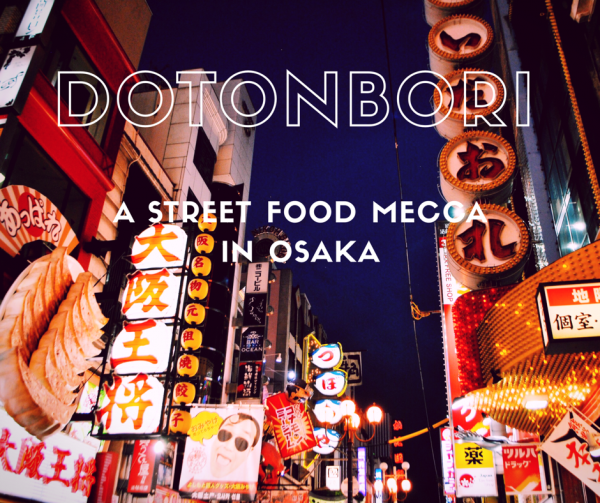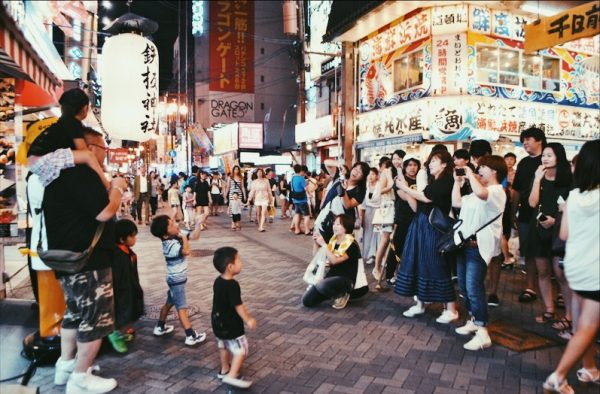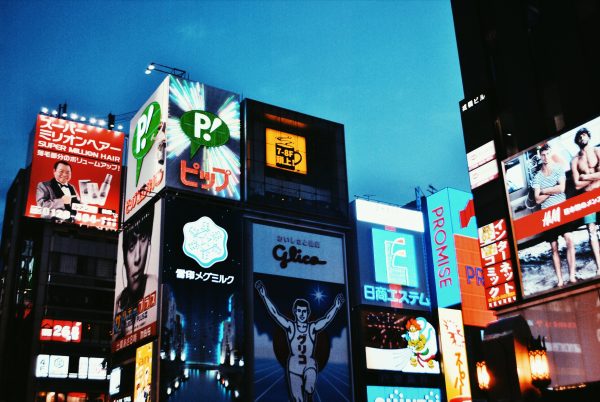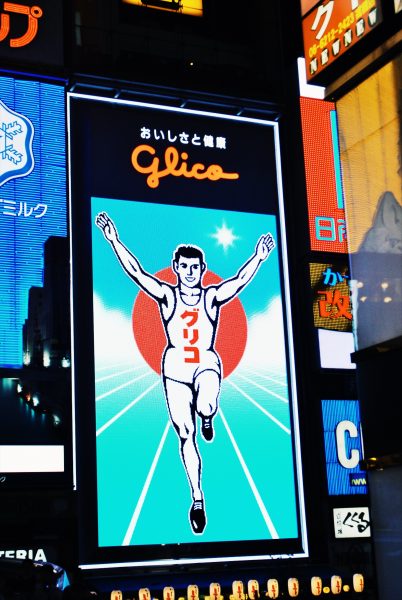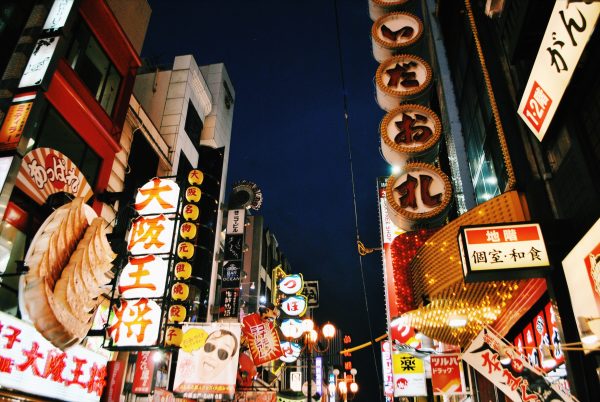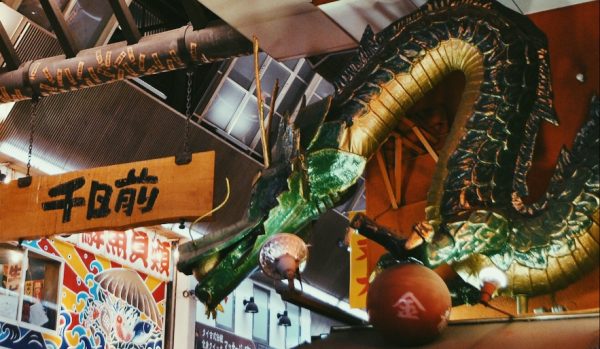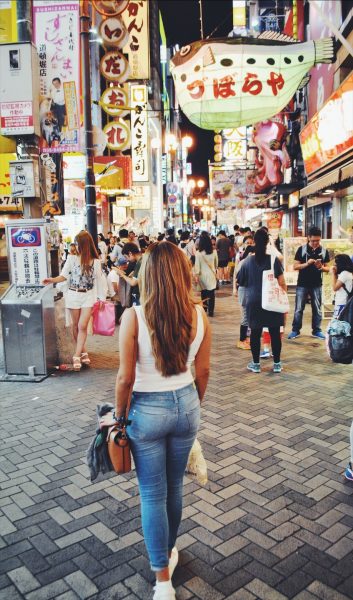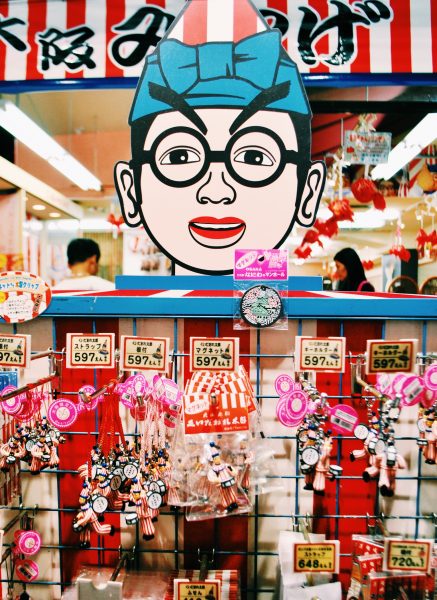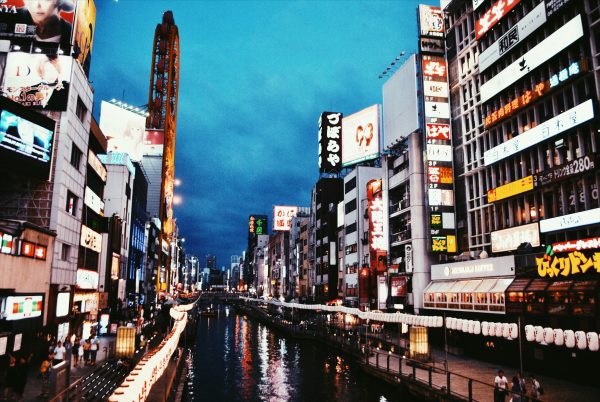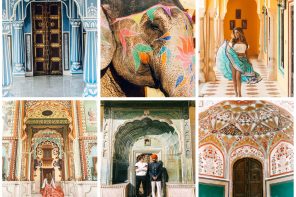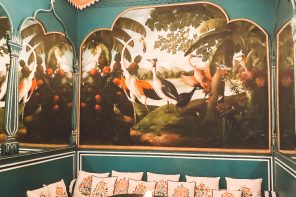Also known as the nation’s kitchen, Japan’s second largest and most prosperous city boats an extraordinary array of restaurants and food stalls that eagerly await to be discovered.
The culinary capital of Japan has an unbelievable number of irresistible signature dishes including takoyaki –octopus stuffed balls-, kushi-katsu –deep fried skewers-, and the filling okonomiyaki, a type of savory pancake full of cabbage often described as Osaka’s soul food.
Few cities can rival Osaka´s street food scene. The long, narrow Dotonbori street attracts millions of tourists annually with its masses of neon lights, eccentric atmosphere and inexpensive food stalls. We came here with an empty stomach wishing to experience Kuidaore, or simply put, to eat ourselves to bankruptcy, and to get absolutely lost in its unique craziness!!
Dotonbori Gourmet Paradise
Nestled along the canal of Umezu river, Dotonbori was definitely a sheer blast of color, an absolute neon carnival where thousands of people snapped pictures with oversize creatures hanging from facades in the background and tucked into food with relish.
Squeezing our way through the massive waves of people, we finally got to the Ebusu-bashi bridge. Originally installed in 1935, the 33m Glico Man is Dotonbori’s most iconic landmark. Interestingly, the famous image of the running man was modelled after a Filipino sprinter named Fortunate Catalon who won the race at the 5th Far Eastern Sport Championship Games in 1921.
It’s just a simple graphic depicting an athlete on a blue track in a victory pose, however what I really loved most about the neon billboard sign is that it maintains its vintage look and feel. The company behind the ad is Esaki Glico, a Japanese confectionery company famous for their traditional Glico caramel candy as well as Pocky (also known as Mikado in Europe).
After crossing the Ebisu-bashi bridge, taking pictures of the famous Glico man and doing some window-shopping, we were ready to try Osaka‘s mouth-watering delicacies.
Osaka‘s love of food is legendary, with staggering line-up restaurants around every street corner. From casual stalls selling local specialties to wallet-busting restaurants, Dotonbori is truly a sensory overload. Utterly fascinated by the smells, the sounds and the incessantly flashing lights, we found it nearly impossible to decide where to eat.
We had already tried kushi-katsu in Shinsekai, Okonomiyaki in Hiroshima and extraordinary ramen in both Tokyo and Kyoto, so these dishes could be easily dropped out of our list. Still, we were in a huge dilemma. Should we try any crab specialty, or should we go for an ultimate fugu dish, or maybe sample some freshly fried gyoza dumplings?
Infinite Options
Dani Doraku is Japan’s iconic crab restaurant easily identified by its giant moving crab billboard. The famous Japanese chain offers a great variety of crab dishes and their well-known signature dish Kani Suki (crab hot pot). A huge red octopus beckons diners into Dotonbori Konamon Museum which sells delicious Takoyaki, Osaka´s number one street food snack.
Another key restaurant in Dotonbori is the legendary Zuboraya. With its giant blowfish lantern, the restaurant rapidly caught our eyes. This small restaurant chain has been serving fugu, or pufferfish since its opening in 1920.
This deadly poisonous fish has been one of the greatest Japanese delicacies for countless centuries. It is estimated that 70% of all the fugu eaten in Japan is consumed in Osaka. The preparation of this infamous deadly delicacy is strictly controlled by law in Japan. Fugu chefs undergo three years of rigurous training and apprenticeship in order to obtain a special licence.
With its iconic golden dragon statue, Kinryu Ramen is one of the most famous ramen shops in Dotonbori area. The restaurant serves a very popular Kyushu-style tonkotsu (pork broth) ramen 24 hours a day.
We couldn’t leave without sampling some Takoyaki at Creo-ru restaurant. Also known as octopus balls, Takoyaki is the city’s most revered street food. We excitedly ate our doughy balls of octopus having a pleasant walk along the lantern lit Dotonbori canal. Crispy on the outside and creamy on the inside, the hot spheres were topped with tangy sauce, mayonnaise, seaweed powder and bonito flakes.
Along the busy Dotonbori avenue we came across a souvenir store of Kuidaore Taro. Since 1950 the iconic drum-playing clown named Kuidatore Taro has been the absolute star of Dotonbori. The cheerful drummer-boy stands in front of the Nakaza building.
Dotonbori Canal
Walking along the promenades of the Dotonbori-gawa Canal after satiating our gluttonous appetite was absolutely magical. The illuminated signboards and neon lamps reflected on the water creating such a special atmosphere. We went back to our hotel with full stomach and the biggest smile ever on our faces!
HOW TO GET TO DOTONBORI
The Dotonbori area is located in the Minami area of Osaka.
Short walk from Namba Station of Subway Midosuji Line (exit No.14)
Latest posts by Rakel (see all)
- Hotel Can Joan Capó- Adults Only, in Sineu (Mallorca) - July 12, 2023
- Northern Light Ranch, Kittila (Finland) - January 23, 2022
- A Quick Guide to Mallorca - November 16, 2021

